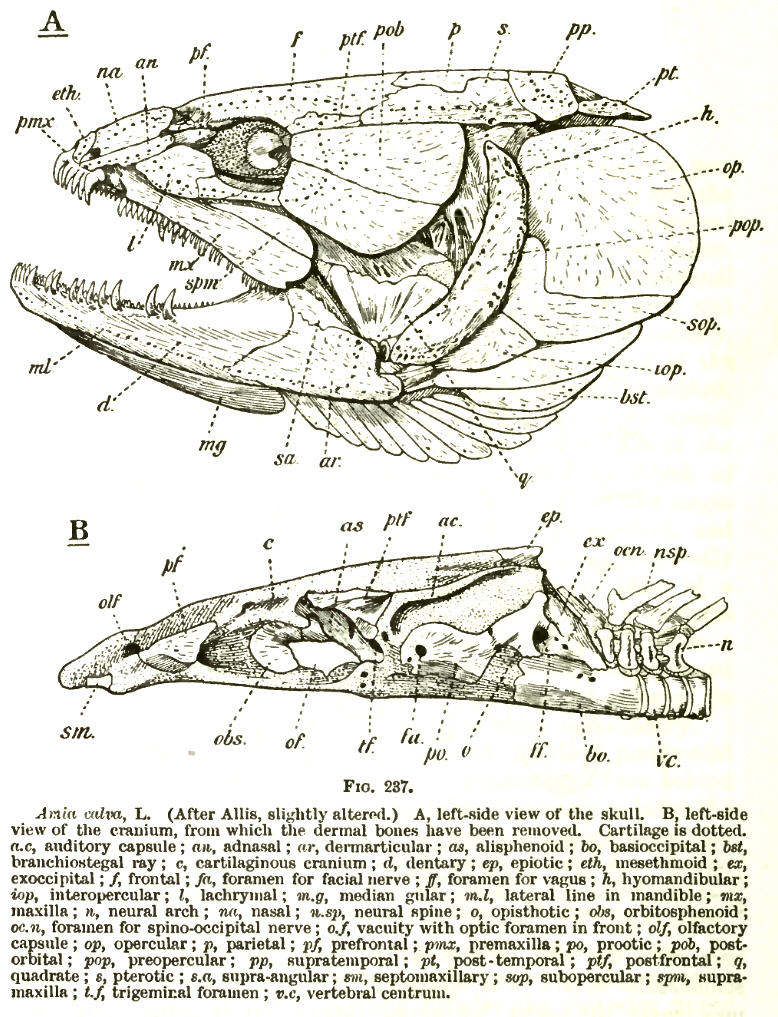Hyomandibula on:
[Wikipedia]
[Google]
[Amazon]
 The hyomandibula, commonly referred to as hyomandibular one(, from , "upsilon-shaped" (υ), and Latin: mandibula, "jawbone"), is a set of bones that is found in the hyoid region in most fishes. It usually plays a role in suspending the jaws and/or operculum ( teleostomi only). It is commonly suggested that in
The hyomandibula, commonly referred to as hyomandibular one(, from , "upsilon-shaped" (υ), and Latin: mandibula, "jawbone"), is a set of bones that is found in the hyoid region in most fishes. It usually plays a role in suspending the jaws and/or operculum ( teleostomi only). It is commonly suggested that in
 The hyomandibula, commonly referred to as hyomandibular one(, from , "upsilon-shaped" (υ), and Latin: mandibula, "jawbone"), is a set of bones that is found in the hyoid region in most fishes. It usually plays a role in suspending the jaws and/or operculum ( teleostomi only). It is commonly suggested that in
The hyomandibula, commonly referred to as hyomandibular one(, from , "upsilon-shaped" (υ), and Latin: mandibula, "jawbone"), is a set of bones that is found in the hyoid region in most fishes. It usually plays a role in suspending the jaws and/or operculum ( teleostomi only). It is commonly suggested that in tetrapods
A tetrapod (; from Ancient Greek τετρα- ''(tetra-)'' 'four' and πούς ''(poús)'' 'foot') is any four- limbed vertebrate animal of the clade Tetrapoda (). Tetrapods include all extant and extinct amphibians and amniotes, with the lat ...
(land animals), the hyomandibula evolved into the columella ( stapes).
Evolutionary context
In jawless fishes, a series ofgill
A gill () is a respiration organ, respiratory organ that many aquatic ecosystem, aquatic organisms use to extract dissolved oxygen from water and to excrete carbon dioxide. The gills of some species, such as hermit crabs, have adapted to allow r ...
s opened behind the mouth, and these gills became supported by cartilaginous elements. The first set of these elements surrounded the mouth to form the jaw. There is ample evidence
For example: (1) both sets of bones are made from neural crest cells (rather than mesoderm
The mesoderm is the middle layer of the three germ layers that develops during gastrulation in the very early development of the embryo of most animals. The outer layer is the ectoderm, and the inner layer is the endoderm.Langman's Medical ...
al tissue like most other bones); (2) both structures form the upper and lower bars that bend forward and are hinged in the middle; and (3) the musculature of the jaw seem homologous to the gill arches of jawless fishes. (Gilbert 2000)
that vertebrate jaws are homologous to the gill arches of jawless fishes. The upper portion of the second embryonic arch supporting the gill became the hyomandibular bone of jawed fishes, which supports the skull and therefore links the jaw to the cranium.
Gilbert 2000, ''Embryonic homologies''
When vertebrates found their way onto land, the hyomandibula, with its location near the ear, began to function as a sound amplifier beside its function to support the skull. As evolution later attached the cranium of terrestrial vertebrates to the rest of the skull, the hyomandibula lost its supportive function and became an interior organ, the stapes, and thus its secondary function had become its primary function.
See also
*Fish anatomy
Fish anatomy is the study of the form or Morphology (biology), morphology of fish. It can be contrasted with fish physiology, which is the study of how the component parts of fish function together in the living fish. In practice, fish anatomy ...
* Palatoquadrate
Notes
References
* * * (3rd and 4th paras, ''One of the most celebrated cases...'') * {{diversity of fish Fish anatomy